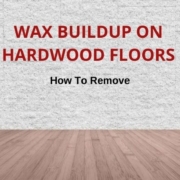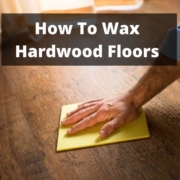How To Clean Unfinished Wood Floors
Whatever type of flooring you have in your home, you want your floor to look its best. To accomplish this, the floor has to be clean.
Yet, different flooring types call for different cleaning methods. For most wood floors, you need only be concerned with cleaning the wood finish and not the wood itself. But what about unfinished wood floors?
In this article, we’ll answer frequently asked questions about cleaning unfinished wood floors. We’ll also discuss practical cleaning solutions that will leave your unfinished wood floors looking as they should in no time.

How Do I Know If My Wood Floor is Finished Or Not?
Granted, different flooring types and colors have been on trend and off throughout the past decade or more. But during this time, for whatever reason, high gloss finish has been decidedly out of fashion. This can make it difficult to tell if a protective finish coat has been applied to the surface of your wood floor.
However, there’s still an easy way to tell if your wood floor is finished. Put a few drops of water onto an inconspicuous area of your wood floor.
Now, leave it there for a minute or two.
If the water stays on the surface, your floor has a finish on it. Just be sure not to put the drops of water near any seams or you could mistakenly assume your floor is unfinished.
Should I Leave My Wood Floor Unfinished?
If you prefer the natural, rustic look of unfinished floors, you’re not alone. But you should know that raw wood floors are more prone to stains, scratches, scuffs, and wood insects without the protection of a finish coat.
Yet, the process for cleaning a raw wood floor isn’t terribly different from cleaning a finished one. Both scenarios call for very gentle treatment.
Cleaning Unfinished Wood Floors — What Not To Do
Before going any further, It’s probably best to get what not to do out of the way and behind us. This list also includes:
What To Avoid And What Not To Bother With
Water
Less is more. Avoid puddling, ponding, and allowing floors to air dry.
String Mop And Bucket
This deluge cleaning method can do more harm than good. It’s also a lot of work. Most professional cleaning services tossed out their string mops and buckets years ago. They now use equipment and products that are less damaging, less unwieldy, and more effective.
Steam Mop
If water should be avoided, then it’s probably best to also avoid injecting wood floors with water heated to 212F
Steel Wool/Steel Brush
Microscopic fragments of steel wool tend to remain on the floor. When these particles rust, they’ll stain.
Vinegar
Many product manufacturers invested vast amounts of human and financial resources to create low VOC content, low odor products that work. Mission accomplished. The products they’ve come up with are very effective.
These products are safe for people, kids, pets, and the environment too. These products include cleaning solutions. Many of these solutions are safe for use on a variety of surface types and they don’t need to be rinsed. Some of these products have a very mild, but pleasant scent.
So, what reasonable explanation could there possibly be for our nation’s incessant predilection with vinegar? Vinegar has the potential to stain an unfinished floor irremediably and it also smells like …like rotting fruit of all things. It’s one thing to leave the stuff in the pantry next to the olive oil. But wiping the floors with it? There’s no reason to make your home smell like that if you don’t have to. There are better options.
Trisodium Phosphate (TSP)
Beginning July 1, 2010, the sale of TSP became limited or prohibited in the following states: Illinois, Indiana, Maryland, Massachusetts, Michigan, Minnesota, Montana, New Hampshire, Ohio, Oregon, Pennsylvania, Utah, Vermont, Virginia, Washington, Wisconsin, and New York. (source)
California had restrictions in place prior to this time.
The reason for the prohibition of trisodium phosphate is the phosphate aspect. Once applied, TSP is carried away in rinse water, also referred to as gray water. The gray water makes its way to ponds, lakes, streams, and rivers where the phosphates fertilize algae and mold. The algae and mold become so prolific that no other form of life can exist wherever they’re present. Ponds, lakes, streams, and rivers become gooey, foamy, and devoid of all flora and fauna.
Of course, we could and probably will go on discussing the virtues of wood floors and singing their praises. But if cleaning a floor or ANY thing involves the use of something that creates a scenario as the one described, then how important can it be?
Fortunately, there are ways to clean your unfinished wood floors that don’t involve threatening our own survival by rubbing nature the wrong way.
For General, Routine Cleaning of Unfinished Wood Floors
You’ll Need To Have and Apply the following As Appropriate :
- Rubber Gloves: Rubber dishwashing gloves tend to be thicker and less prone to tearing than Latex.
- Floor Vacuum Or Floor Accessory Vacuum Attachment: A floor vacuum’s row of short, soft bristles located in close proximity to your unfinished wood floor is an extremely effective way to remove dust and debris.
- A Soft-Bristled Broom: Provided you don’t sweep abrasive debris across the floor instead of directly into a dustpan, this type of broom is also effective in the removal of dust and debris.
- Sweeping Compound: Sweeping compound is a sort of moisturized sawdust. Lightly toss small handfuls onto the floor and sweep it up with your soft-bristled broom. Dust and dirt are absorbed by the compound. This keeps them anchored where they might otherwise be disturbed and sent into the air only to settle on your floors again later.
Note: It’s called “sweeping” compound for a reason. You’ll risk frying your vacuum if you attempt to suck up the compound with it.
The moisture contained in the sweeping compound is all the moisture that should be involved in the general, routine cleaning of an unfinished wood floor.
How To Deep Clean Unfinished Wood Floors
In Addition to The General Cleaning Items Above, You’ll Need:
- Respirator
- Mop With Flat Microfiber Mop Head: The wider the mop head, the better. A wide mop head covers more floor in less time.
- Clean Terry Cloth or Microfiber Rags
- 1 Quart Spray Bottle
- 1 Quart Hot Water
- Mineral Spirits: The fumes released by mineral spirits are very heavy and noxious. Be sure the room you’re working in is well ventilated. If the ventilation is insufficient, wear a respirator and protective gloves.
- Borax: Borax (boron) is a mineral that’s used as an insecticide, an all-purpose cleaner, and a flame retardant. It also eliminates and repels fungi, wood rot, termites, wood boring beetles, bark beetles, and carpenter ants. Properly diluted, the cost of a borax liquid solution is about 0.02/oz. All this makes for an excellent wood floor cleaner.
- Murphy’s Oil Soap: Instead of borax, you can use Murphy’s Oil Soap that’s sold in a spray bottle.
Directions For Deep Cleaning Unfinished Wood Floors
- Remove dust, dirt, and debris as explained in General Routine Cleaning, above
- Dampen the mop with water
- Dissolve 2 oz borax into 1-quart hot water.
- Transfer the borax solution into the spray bottle. Allow any undissolved granules to remain untransferred. This will keep them from clogging the sprayer.
- Working in sections of about 3’ x 3’, spray the borax solution or if you prefer, Murphy’s Oil Soap onto the floor.
- Mop the sprayed section.
- Use a terry cloth or microfiber rag to wipe the mopped section dry
- Move onto the next section of the floor. Spray, mop, dry.
- Continue until the entire floor is clean.
How To Remove Stains From An Unfinished Wood Floor
If There Is A Stain That Cleaning Your Unfinished Wood Floor Didn’t Remove
- Put a small amount of mineral spirits onto a clean rag.
- Dab the saturated part of the rag onto the stain, increasing pressure as necessary.
- Add more mineral spirits onto a fresh section of the rag. Continue to dab, don’t wipe the stain.
Unless the stain is a deeply set water or urine stain, this process should ultimately remove it.
If the stain is deep, you can try hydrogen peroxide to remove it or you can sand it, or both. Start with 80 grit, then 100, 120, and finally,150.
If the stains on your unfinished wood floor are considerable in size or number, you might want to consider renting an orbital or drum sander to sand the entire floor.
Although sanding a large area of wood floor is another project in itself, the information with respect to cleaning still applies as does the information contained in the rest of this article.
How To Make An Unfinished Wood Floor Shine
Although it’s not as popular as it was during the 1940s, ’50s, and ’60s, the application of paste wax still gives as warm a luster to wood floors as ever. If you intend to wax your unfinished wood floor, you’ll need the following:
- Terry cloth towels or rags
- Microfiber cloths
- Sponge Mop
- Respirator
- Rubber Gloves
- Paste wax. You can choose a clear paste wax or one with a wood stain. You can also use a liquid floor wax.
Applying Paste Wax To An Unfinished Wood Floor
Before you start, you’ll need to be sure to take care of yourself. Although the fumes tend to dissipate reasonably quickly, waxes of this kind are nevertheless solvent-based. The work area must be well ventilated. Consider wearing a respirator. Protective gloves should also be worn.
Working in sections of 3’ x 3’, put a tablespoon of wax onto a clean cloth and coat the floor wiping in the direction of the grain. If you’re using liquid wax, put a tablespoon of it on the floor and use a mop to coat the floor. You will need to use a cloth to apply wax in corners and tight spots.
Allow an hour for the wax to dry before applying the next coat. Liquid wax requires at least two coats whereas its solid counterpart requires not more than two coats.
Buffing Unfinished Wood Floor
The buffing process additionally protects waxed wood floors by moving the wax further into the wood’s surface.
Use a cloth to buff the wax into the floor. For liquid floor wax, use a terry cloth rag.
Alternatively, you can rent a floor buffer for about $50 daily. This might be money well spent as this type of machine makes quick work of buffing and polishing.
While it represents some effort on the owner’s part, the choice to leave a wood floor unfinished is becoming increasingly popular. The reason for this is the considerable savings realized by not having to restore the floor which involves hiring a professional.
Table of Contents







